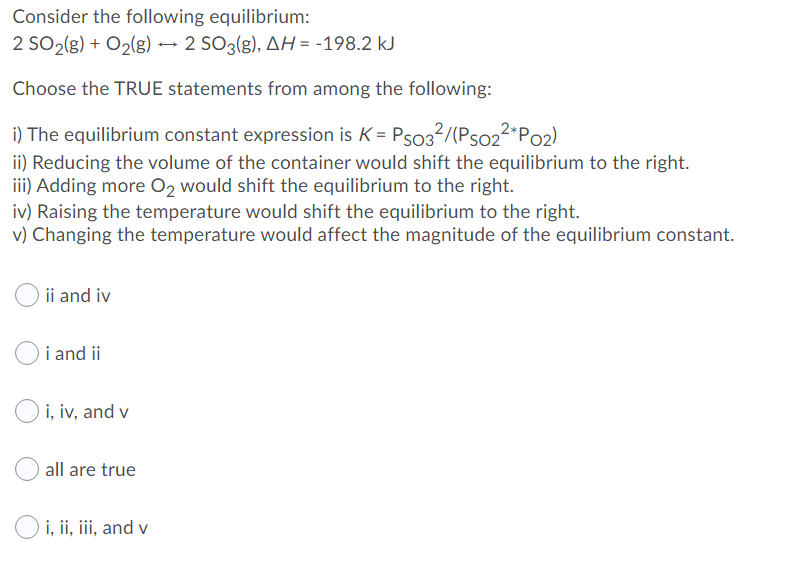Consider the following equilibrium: 2 SO2(g) + O2(g) → 2 SO3(g), AH = -198.2 kJ Choose the TRUE statements from among the following: i) The equilibrium constant expression is K = Pso32/(Pso2²*Po2) ii) Reducing the volume of the container would shift the equilibrium to the right. iii) Adding more O2 would shift the equilibrium to the right. iv) Raising the temperature would shift the equilibrium to the right. v) Changing the temperature would affect the magnitude of the equilibrium constant. ii and iv i and ii O i, iv, and v all are true
Consider the following equilibrium: 2 SO2(g) + O2(g) → 2 SO3(g), AH = -198.2 kJ Choose the TRUE statements from among the following: i) The equilibrium constant expression is K = Pso32/(Pso2²*Po2) ii) Reducing the volume of the container would shift the equilibrium to the right. iii) Adding more O2 would shift the equilibrium to the right. iv) Raising the temperature would shift the equilibrium to the right. v) Changing the temperature would affect the magnitude of the equilibrium constant. ii and iv i and ii O i, iv, and v all are true
Chemistry: Principles and Reactions
8th Edition
ISBN:9781305079373
Author:William L. Masterton, Cecile N. Hurley
Publisher:William L. Masterton, Cecile N. Hurley
Chapter12: Gaseous Chemical Equilibrium
Section: Chapter Questions
Problem 14QAP: Consider the following reaction at 1000 C: NO(g)+12 Cl2(g)NOCl(g) (a) Write an equilibrium constant...
Related questions
Question

Transcribed Image Text:Consider the following equilibrium:
2 SO2(g) + O2(g) → 2 SO3(g), AH = -198.2 kJ
Choose the TRUE statements from among the following:
i) The equilibrium constant expression is K = Pso3?/(Pso2²*Po2)
ii) Reducing the volume of the container would shift the equilibrium to the right.
iii) Adding more O, would shift the equilibrium to the right.
iv) Raising the temperature would shift the equilibrium to the right.
v) Changing the temperature would affect the magnitude of the equilibrium constant.
ii and iv
i and ii
O i, iv, and v
all are true
O i, ii, iii, and v
Expert Solution
This question has been solved!
Explore an expertly crafted, step-by-step solution for a thorough understanding of key concepts.
This is a popular solution!
Trending now
This is a popular solution!
Step by step
Solved in 2 steps with 1 images

Knowledge Booster
Learn more about
Need a deep-dive on the concept behind this application? Look no further. Learn more about this topic, chemistry and related others by exploring similar questions and additional content below.Recommended textbooks for you

Chemistry: Principles and Reactions
Chemistry
ISBN:
9781305079373
Author:
William L. Masterton, Cecile N. Hurley
Publisher:
Cengage Learning

Chemistry: Principles and Practice
Chemistry
ISBN:
9780534420123
Author:
Daniel L. Reger, Scott R. Goode, David W. Ball, Edward Mercer
Publisher:
Cengage Learning

Chemistry: The Molecular Science
Chemistry
ISBN:
9781285199047
Author:
John W. Moore, Conrad L. Stanitski
Publisher:
Cengage Learning

Chemistry: Principles and Reactions
Chemistry
ISBN:
9781305079373
Author:
William L. Masterton, Cecile N. Hurley
Publisher:
Cengage Learning

Chemistry: Principles and Practice
Chemistry
ISBN:
9780534420123
Author:
Daniel L. Reger, Scott R. Goode, David W. Ball, Edward Mercer
Publisher:
Cengage Learning

Chemistry: The Molecular Science
Chemistry
ISBN:
9781285199047
Author:
John W. Moore, Conrad L. Stanitski
Publisher:
Cengage Learning

Chemistry for Engineering Students
Chemistry
ISBN:
9781337398909
Author:
Lawrence S. Brown, Tom Holme
Publisher:
Cengage Learning

Chemistry: An Atoms First Approach
Chemistry
ISBN:
9781305079243
Author:
Steven S. Zumdahl, Susan A. Zumdahl
Publisher:
Cengage Learning
